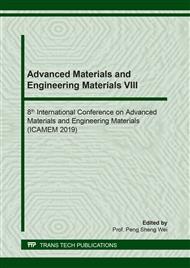[1]
X.F. Wang, C. Fang, W.Q. Kuang, D.W. Li, N.X. Han, F. Xing, Experimental investigation on the compressive strength and shrinkage of concrete with pre-wetted lightweight aggregates, Constr. Build. Mater. 155 (2017) 867-879.
DOI: 10.1016/j.conbuildmat.2017.07.224
Google Scholar
[2]
L.M. Wu, N. Farzadnia, C.J. Shi, Z.H. Zhang, H. Wang, Autogenous shrinkage of high performance concrete: A review, Constr. Build. Mater. 149 (2017) 62-75.
DOI: 10.1016/j.conbuildmat.2017.05.064
Google Scholar
[3]
S. Ghourchian, M. Wyrzykowski, L. Baquerizo, P. Lura, Susceptibility of Portland cemen t and blended cement concretes to plastic shrinkage cracking, Cem. Concr. Compos. 85 (2018) 44-55.
DOI: 10.1016/j.cemconcomp.2017.10.002
Google Scholar
[4]
H.N. Wei, Y.K. Wang, J.J. Luo, Influence of magnetic water on early-age shrinkage cracking of concrete, Constr. Build. Mater. 147 (2017) 91-100.
DOI: 10.1016/j.conbuildmat.2017.04.140
Google Scholar
[5]
M. Maslehuddin, M. Ibrahim, M. Shameem, M.R. Ali, M.H. Al-Mehthel, Effect of curing methods on shrinkage and corrosion resistance of concrete, Constr. Build. Mater. 41 (2013) 634-641.
DOI: 10.1016/j.conbuildmat.2012.12.064
Google Scholar
[6]
R.J. Thomas, D. Lezama, S. Peethamparan, On drying shrinkage in alkali-activated concrete: Improving dimensional stability by aging or heat-curing, Cem. Concr. Res. 91 (2017) 13-23.
DOI: 10.1016/j.cemconres.2016.10.003
Google Scholar
[7]
G. Adegoloye, A.L. Beaucour, S. Ortola, A. Noumowe, Mineralogical composition of EAF slag and stabilised AOD slag aggregates and dimensional stability of slag aggregate concretes, Constr. Build. Mater. 115 (2016) 171-178.
DOI: 10.1016/j.conbuildmat.2016.04.036
Google Scholar
[8]
M.J. Oliveira, A.B. Riberiro, F.G. Branco, Combined effect of expansive and shrinkage reducing admixtures to control autogenous shrinkage in self-compacting concrete, Constr. Build. Mater. 52 (2014) 267-275.
DOI: 10.1016/j.conbuildmat.2013.11.033
Google Scholar
[9]
Y. Wehbe, A. Ghahremaninezhad, Combined effect of shrinkage reducing admixtures (SRA) and superabsorbent polymers (SAP) on the autogenous shrinkage, hydration and properties of cementitious materials, Constr. Build. Mater. 138 (2017) 151-162.
DOI: 10.1016/j.conbuildmat.2016.12.206
Google Scholar
[10]
K.L. Scrivener, P. Juilland, P.J.M. Monteiro, Advances in understanding hydration of Portland cement, Cem. Concr. Res. 78 (2015) 38-56.
DOI: 10.1016/j.cemconres.2015.05.025
Google Scholar
[11]
V. Corinaldesi, Combined effect of expansive, shrinkage reducing and hydrophobic admixtures for durable self compacting concrete, Constr. Build. Mater. 36 (2012) 758-764.
DOI: 10.1016/j.conbuildmat.2012.04.129
Google Scholar
[12]
A.B. Eberhardt, R.J. Flatt, Working mechanisms of shrinkage reducing admixtures, Sci. Techn. Concr. Admixt. 13 (2016) 305-320.
DOI: 10.1016/b978-0-08-100693-1.00013-8
Google Scholar
[13]
D.Y. Yoo, J. Kim, G. Zi, Y. Yoon, Effect of shrinkage reducing admixture on biaxial flexural behavior of ultra-high-performance fiber-reinforced concrete, Constr. Build. Mater. 89 (2015) 67-75.
DOI: 10.1016/j.conbuildmat.2015.04.040
Google Scholar
[14]
W.Q. Zuo, P. Feng, P.H. Zhong, Q. Tian, C.W. Miao, Effects of novel polymer type shrinkage reducing admixture on early age autogenous deformation of cement pastes, Cem. Concr. Res. 100 (2017) 413-422.
DOI: 10.1016/j.cemconres.2017.08.007
Google Scholar
[15]
W.Y. Zhang, Y. Hama, S.H. Na, Drying shrinkage and microstructure characteristics of mortar incorporating ground granulated blast furnace slag and shrinkage reducing admixture, Constr. Build. Mater. 93 (2015) 267-277.
DOI: 10.1016/j.conbuildmat.2015.05.103
Google Scholar
[16]
P.L. Ng, J.J. Chen, A.K.H. Kwan, Adiabatic Temperature Rise of Concrete with Limestone Fines Added as a Filler, Proc. Engin. 172 (2017) 768-775.
DOI: 10.1016/j.proeng.2017.02.121
Google Scholar
[17]
X.Y. Li, W.Y. Chen, W.M. Chen, Multi-powder dam concrete with high performance and low adiabatic temperature rise, Comp. Struct. 84 (2006) 2351-2362.
Google Scholar
[18]
Y.J. Bie, S. Qiang, X. Sun, J.D. Song, A new formula to estimate final temperature rise of concrete considering ultimate hydration based on equivalent age, Constr. Build. Mater. 142 (2017) 514-520.
DOI: 10.1016/j.conbuildmat.2017.03.116
Google Scholar
[19]
J. Gu, J. Huang, H.y. Hao, Influence of mud cake solidification agents on thickening time of oil well cement and its solution, Constr. Build. Mater. 153 (2017) 327-336.
DOI: 10.1016/j.conbuildmat.2017.07.128
Google Scholar
[20]
K. Kupwade-Patil, S.D. Palkovic, A. Bumajdad, C. Soriano, O. Büyüköztürk, Use of silica fume and natural volcanic ash as a replacement to Portland cement: Micro and pore structural investigation using NMR, XRD, FTIR and X-ray microtomography, Constr. Build. Mater. 158 (2018) 574-590.
DOI: 10.1016/j.conbuildmat.2017.09.165
Google Scholar
[21]
D. Gastaldi, G. Paul, L. Marchese, S. Irico, E. Boccaleri, S. Mutke, L. Buzzi, F. Canonico, Hydration products in sulfoaluminate cements: Evaluation of amorphous phases by XRD/ solid-state NMR, Cem. Concr. Res. 90 (2016) 162-173.
DOI: 10.1016/j.cemconres.2016.05.014
Google Scholar


